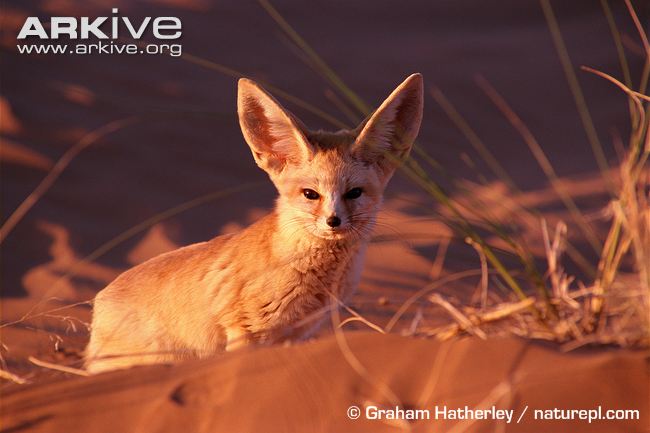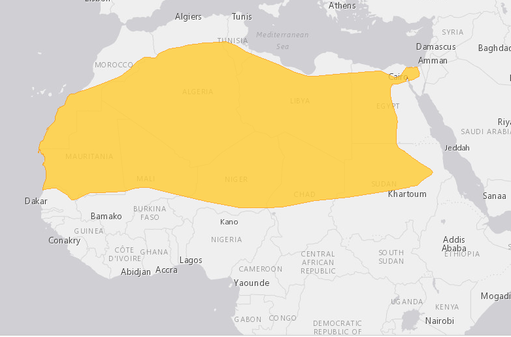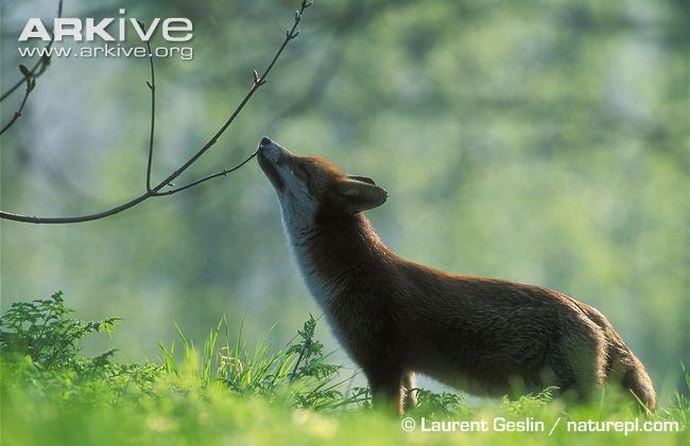 Fennec fox in dessert, Graham Hatherley, www.Arkive.org
Fennec fox in dessert, Graham Hatherley, www.Arkive.org Kingdom: Animalia Phylum: Chordata Class: Mammalia Order: Carnivora
Family: Canidae Genus: Vulpes Species: V. zerda[1]
The secondary species of focus, Vulpes zerda; commonly known as the fennec fox[1]. This breed is often referred to as the cutest breed of foxes[2]. Distinguished by its large ears, creamy-yellow coat with a black-tipped tail, they are the smallest of the world’s foxes[2]. Generally they grow up to 9-16 inches in body length, with a 7-12 inch tail in adults[2]. Their massive ears can grow up to 6 inches long[2]. The average weight for the fennec fox is around 1.5-3.5 lb[2]. expected life expectancy is around 14 years in captivity, although few survive that long in the wild[2].
This little fox is native to the Saharan desert of Northern Africa[3]. Their bodies are adapted to live in the harsh environments of the endless beating sun[3]. Its large ears help dissipate heat as many blood vessels are located near the surface[3]. Fur-padded paws provide protection when running across the hot sand[3]. A fluffy sand-colour coat helps it deflect the hot arid sun during the day, while keeping it nice and warm at nighttime[3]. The fennec makes its home in burrows in the sand. During the day, they are sleeping and the burrows provide a nice cool environment[2].
Breeding occurs from January to March, after 52 days the vixen gives birth[2]. Unlike red foxes, fennecs only produce a litter of up to 5 pups[2]. At birth, the pups weigh only 50 grams and are typically born with a grey coat[2]. Males will be kept away from the den until the pups are older[3].
These particular foxes do not have musk glands, which makes them a popular exotic pet in certain parts of the world[2].
References:
1. Asa, C.S., Valdespino, C., Cuzin, F., de Smet, K. & Jdeidi, T. 2008. Vulpes zerda. The IUCN Red List of Threatened Species. Version 2014.3. <www.iucnredlist.org>. Downloaded on 02 March 2015.
2. Dampsey, J., Hanna, S., Asa, C., Bauman, K., 2009. Nutrition and Behavior of Fennec Foxes (Vulpes zerda). Vet. Clin. Exot. Anim. 12, 299-312.
3. Brahmi, K., Khechekhouche, E., Mostefaoui, O., Doumandji, S., Baziz, B., Aulangnier, S., 2012. First quantitative data on the diet of the fennec fox, Vulpes zerda (Canidae, Carnivora), in Algeria. Folia. Zool. 61, 61-70.
Family: Canidae Genus: Vulpes Species: V. zerda[1]
The secondary species of focus, Vulpes zerda; commonly known as the fennec fox[1]. This breed is often referred to as the cutest breed of foxes[2]. Distinguished by its large ears, creamy-yellow coat with a black-tipped tail, they are the smallest of the world’s foxes[2]. Generally they grow up to 9-16 inches in body length, with a 7-12 inch tail in adults[2]. Their massive ears can grow up to 6 inches long[2]. The average weight for the fennec fox is around 1.5-3.5 lb[2]. expected life expectancy is around 14 years in captivity, although few survive that long in the wild[2].
This little fox is native to the Saharan desert of Northern Africa[3]. Their bodies are adapted to live in the harsh environments of the endless beating sun[3]. Its large ears help dissipate heat as many blood vessels are located near the surface[3]. Fur-padded paws provide protection when running across the hot sand[3]. A fluffy sand-colour coat helps it deflect the hot arid sun during the day, while keeping it nice and warm at nighttime[3]. The fennec makes its home in burrows in the sand. During the day, they are sleeping and the burrows provide a nice cool environment[2].
Breeding occurs from January to March, after 52 days the vixen gives birth[2]. Unlike red foxes, fennecs only produce a litter of up to 5 pups[2]. At birth, the pups weigh only 50 grams and are typically born with a grey coat[2]. Males will be kept away from the den until the pups are older[3].
These particular foxes do not have musk glands, which makes them a popular exotic pet in certain parts of the world[2].
References:
1. Asa, C.S., Valdespino, C., Cuzin, F., de Smet, K. & Jdeidi, T. 2008. Vulpes zerda. The IUCN Red List of Threatened Species. Version 2014.3. <www.iucnredlist.org>. Downloaded on 02 March 2015.
2. Dampsey, J., Hanna, S., Asa, C., Bauman, K., 2009. Nutrition and Behavior of Fennec Foxes (Vulpes zerda). Vet. Clin. Exot. Anim. 12, 299-312.
3. Brahmi, K., Khechekhouche, E., Mostefaoui, O., Doumandji, S., Baziz, B., Aulangnier, S., 2012. First quantitative data on the diet of the fennec fox, Vulpes zerda (Canidae, Carnivora), in Algeria. Folia. Zool. 61, 61-70.



